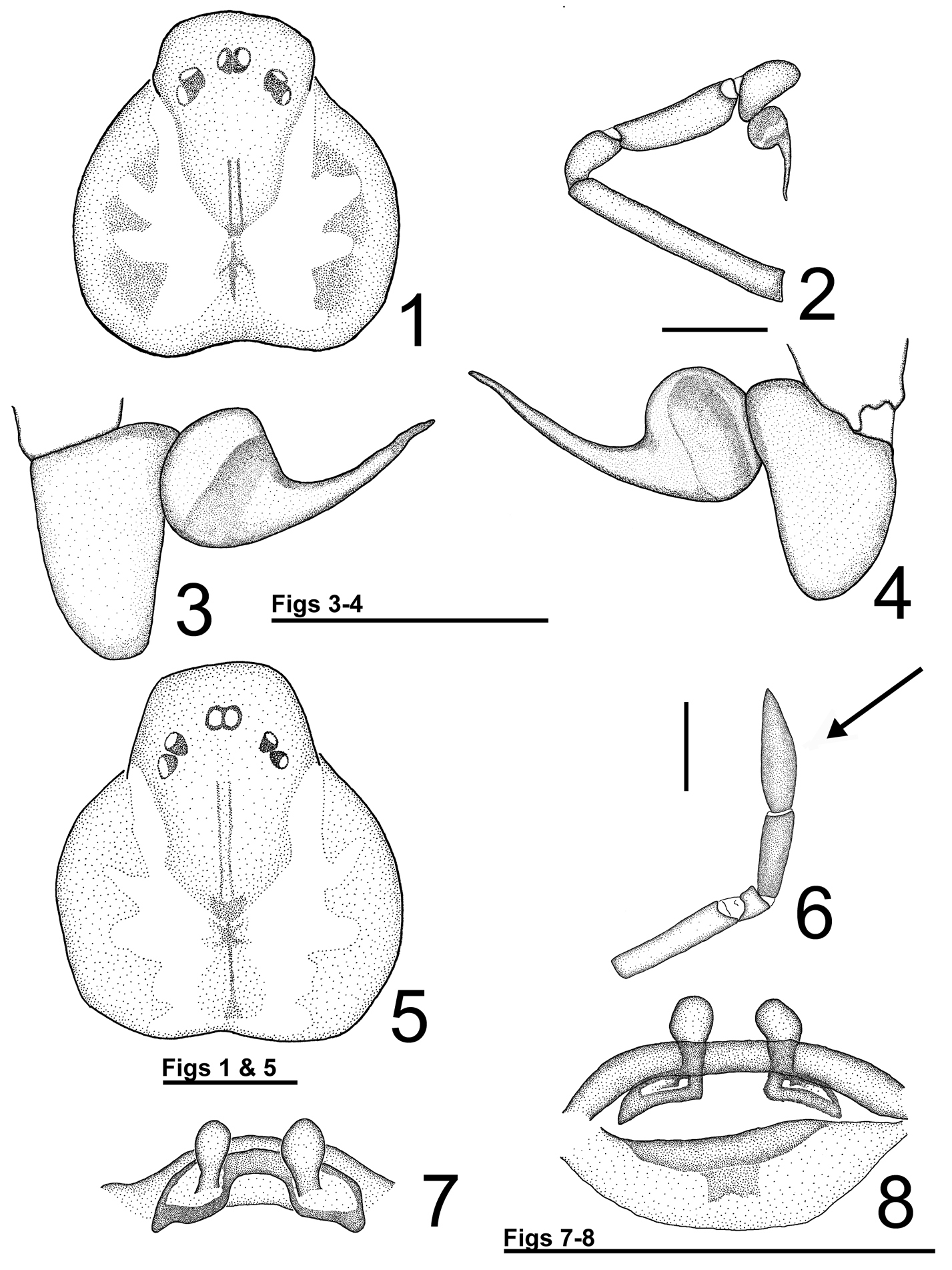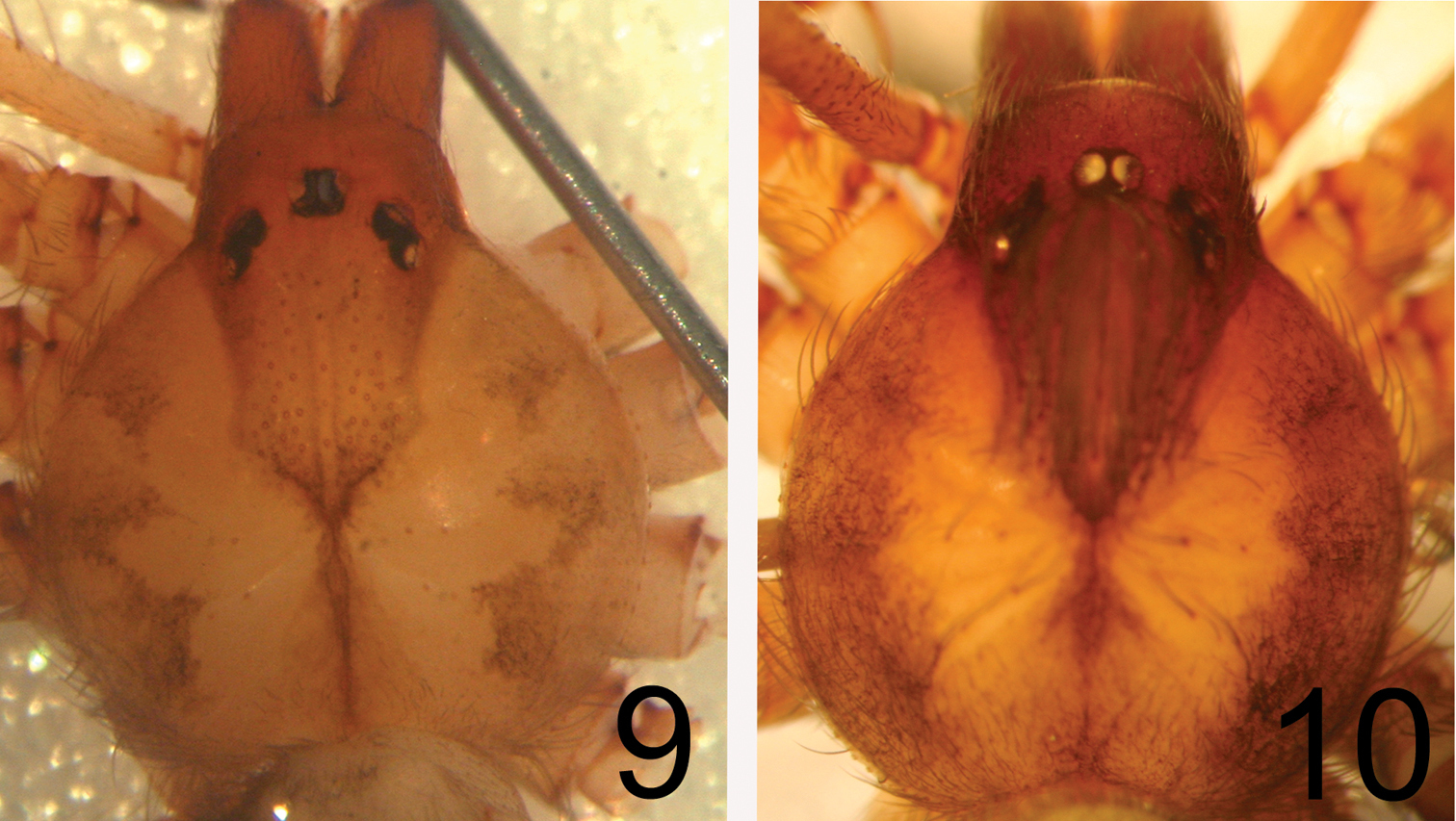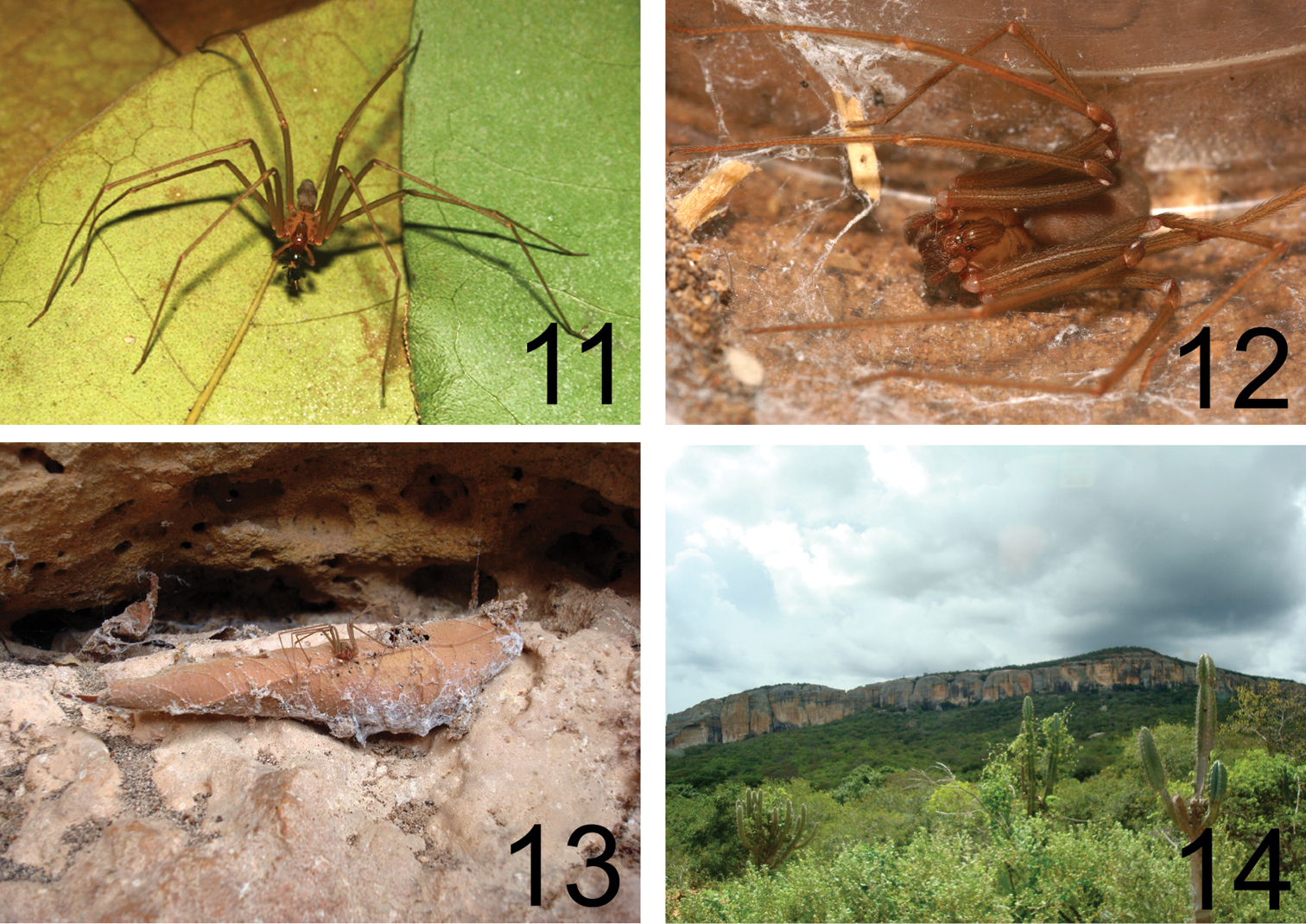






(C) 2012 Rute Maria Gonçalves-de-Andrade. This is an open access article distributed under the terms of the Creative Commons Attribution License 3.0 (CC-BY), which permits unrestricted use, distribution, and reproduction in any medium, provided the original author and source are credited.
For reference, use of the paginated PDF or printed version of this article is recommended.
A new species of recluse spider, Loxosceles niedeguidonae sp. n., is described from the Parque Nacional Serra da Capivara, State of Piauí, Brazil. This is the first endemic species described from Brazilian semi-arid environment. The species is included in gaucho group of
Brown spider, Semi-arid region, Piauí, Taxonomy, Araneae, Sicariidae, Loxosceles, Loxosceles niedeguidonae
The Loxosceles Heineken & Lowe, 1832 species, brown recluse spiders, are spread throughout the world. Currently, there are 102 species described for the whole Neotropical region, Europe, Asia and Africa, eleven of them present and/or endemic to Brazil (
In general, for the classified species of this genus the authors have adopted the species groups proposed by
After
The Parque Nacional Serra da Capivara is a federal protected area in Southeastern State of Piauí, Brazil. The 129, 953 ha cover areas in the municipalities of São Raimundo Nonato, Coronel José Dias, João Costa and Brejo do Piauí (08°26', 08°54'S and 42°19', 42°45'W). Together with Parque Nacional Serra das Confusões it is one of the largest protected areas in the world with “Caatinga” vegetation formation, situated between the “Médio São Francisco” depression (Precambriam) and the Piauí–Maranhão sedimentary basin (Silurian-Devonian), the two largest geological formations in Brazilian Northeastern. Rainfall period is from November to March, with a yearly median precipitation of 689 mm. The annual median temperature is 28°C. General landscape of Parque Nacional da Serra da Capivara consists of uplands, plateaus, hills, mountain chains and plains. This distinct relief is a result of transformations occurring during millions of years in the sedimentar basin of Piauí–Maranhão and in the central São Francisco Depression composed of different types of minerals and rocks.
In this work we describe a new species of Loxosceles endemic to the Brazilian semiarid environment, from Parque Nacional Serra da Capivara, the second species of the gaucho group described for Northeastern Brazil and present an updated key for Loxosceles species of gaucho group.
Material and methodsSpiders were collected (the permissions for collect - number 11971-2 - and for work in Parque Nacional Serra da Capivara – number 18413-1 - was conceded to Rute Maria Gonçalves-de-Andrade by ICMBio a instance of the Brazilian Ministry of the Environment) in two localities: Toca do Buraco da Pedra Furada and Boqueirão do Gato. The specimens examined are deposited in Museu Nacional, Rio de Janeiro, RJ, Brazil (Dr. Adriano B. Kury). The copulatory organs of females were dissected and cleared with clove oil. A LEICA® MZ7.5 Stereomicroscope with 10x eyepiece was used for illustrations (with a camera lucida attachment) and measurements (using an ocular micrometer). Measurements are in millimeters. Abbreviations: ALE = anterior lateral eye, PLE = posterior lateral eye and PME = posterior median eye.
Taxonomy [Modified from
| 1 | Males | 2 |
| – | Females | 7 |
| 2 | Palpal tibia more than 2 times longer than palpal tarsus | 3 |
| – | Palpal tibia at most 1.5 times longer than palpal tarsus | 4 |
| 3 | Palpal tarsus almost 2 times longer than wide (Figs 2–4); lateral dentate dark bands on the dorsal side of the carapace faded (Fig. 9) | Loxosceles niedeguidonae sp. n. |
| – | Palpal tarsus less than 1.5 times longer than wide; lateral dentate dark bands on dorsal side of the carapace conspicuous (Fig. 10) | Loxosceles chapadensis |
| 4 | First femur 2.1 times, first leg more than seven times longer than carapace | 5 |
| – | First femur at most 1.7 times, first leg at most seven times longer than carapace | 6 |
| 5 | Embolus straight in ventral view ( |
Loxosceles adelaida |
| – | Embolus strongly curved in ventral view ( |
Loxosceles similis |
| 6 | Femur of palpus 3 times longer than wide ( |
Loxosceles gaucho |
| – | Femur of palpus 5 times longer than wide ( |
Loxosceles variegata |
| 7 | Palpal tarsus incrassated and broader than palpal tibia (Fig. 6) | 8 |
| – | Tarsus evenly tapered | 9 |
| 8 | Seminal receptacles inconspicuous | Loxosceles adelaida |
| – | Seminal receptacles conspicuous (Figs 7–8) | Loxosceles niedeguidonae sp. n. |
| 9 | Seminal receptacles small, oval pouches ( |
Loxosceles variegata |
| – | Seminal receptacles much larger | 10 |
| 10 | Seminal receptacles curved ( |
Loxosceles gaucho |
| – | Seminal receptacle straight or almost so; first femur 1.8 times longer than carapace | 11 |
| 11 | Dorsal part of the bursa copulatrix weakly sclerotized ( |
Loxosceles similis |
| – | Dorsal part of the bursa copulatrix strongly sclerotized ( |
Loxosceles chapadensis |
urn:lsid:zoobank.org:act:ED9F0A10-B566-4989-AB71-00E1F96BD38E
http://species-id.net/wiki/Loxosceles_niedeguidonae
Figures 1 –13Holotype: male: Brazil, Piauí, Coronel José Dias, Boqueirão do Sítio da Pedra Furada – Toca, 8°51'S, 42°33'W, 16 March 2009, R. M. Gonçalves-de-Andrade & Maria Fátima Ribeiro Barbosa (MNRJ 04359).
Paratype female (MNRJ 04360) with same data as for holotype.
Loxosceles chapadensis. Holotype: Male: Brazil, Bahia, Palmeiras, Chapada Diamantina National Park (12°28'S, 41°25'W), 15 February 2008, R. Bertani, C. S. Fukushima & R. H. Nagahama, (MNRJ 6047); Paratypes: Brazil, Bahia: 1 female, with same data as for holotype (MNRJ 6048); 3 females and 1 male, Lençóis, Chapada Diamantina National Park (12°33'S, 41°23'W), 19 February 2008, same collectors as for holotype, (MNRJ 6049); 1 female, Iraquara, Fazenda Pra- tinha (12°21'S, 41°32'W), 16.II.2008, same collectors as for holotype, (MNRJ 6050).
Males can be readily distinguished from other species, except Loxosceles chapadensis by the following characters in combination: Palpal tibia more than 1.5 times longer than tarsus, embolus 1.5–1.8 times longer than diameter of tegulum, arising at distal half of tegulum, distally thin but not filiform and hardly curved, particularly not in distal direction (Fig. 2). Males differ from Loxosceles chapadensis by palpal tarsus almost two times longer than wide (Figs 2–4), embolus less curved (Fig. 4) and faded lateral dentate dark bands on the dorsal side of the carapace (Fig. 9). Females can be recognized by the following characters in combination: A narrow transversal plate in the spermathecae, straight, apically enlarged seminal receptacles and incrassate palpal tarsus, which is broader than palpal tibia (Figs 6–8).
Loxosceles niedeguidonae sp. n. 1–4 holotype male 1 carapace 2 left palp 3 bulb, prolateral view 4 bulb, retrolateral view 5–8 paratype female 5 carapace 6 right palp - incrassate tarsus (arrow) 7 spermathecae, dorsal view 8 spermathecae, ventral view. Scale bar: 1 mm.
The specific name is a patronym in honor of Dr Niéde Guidon, one of the most important Brazilian archeologists, internationally acknowledged for her archeological work and her battle for the preservation of archeological sites in Brazil and the conservation of remnant patches of Caatinga vegetation, as well as important social work, especially in the Parque Nacional da Serra da Capivara.
Male(holotype). Total length (without chelicerae) 6.01. Carapace 3.29 long, 3.1 wide. Eye size: ALE: 0.2, PME: 0.22, PLE: 0.18. Clypeus: 0.32. Interocular distance - PME and PLE: 0.04, PME and ALE: 0.2. Leg formula: II, IV, I, III. Legs and palp length and width in Table 1. Labium 0.75 long, 0.42 wide. Sternum 1.59 long, 1.48 wide. Femur I 2.58 times longer than the carapace. Palpal femur 7.13 times longer than wide, tibia 2.81 times longer than wide (Fig. 2), tarsus almost two times longer than wide (Figs 3–4). Bulb suboval, slightly shorter than tarsus length. Embolus almost straight, approximately two times longer than bulb width, without carina (Fig. 4). Cephalic region of carapace covered by many long setae. Carapace with pars cephalic and chelicerae light brown (Fig. 1). Pars thoracica pale yellow, carapace border mottled, light brown (Figs 1, 9). Legs and palps pale yellow, covered by short grayish setae. Coxae and sternum pale yellow, labium and endites brown. Abdomen covered with grayish setae.
Loxosceles niedeguidonae sp. n. Male holotype. Length/width of right legs and palpal segments.
| Palp | I | II | III | IV | |
|---|---|---|---|---|---|
| Tarsi | 0.75/0.46 | 1.9/0.1 | 1.75/0.12 | 1.37/0.12 | 1.75/0.12 |
| Metatarsi | --- | 11.4/0.2 | 13.87/0.12 | 2.05/0.25 | 12.12/0.25 |
| Tibiae | 1.55/0.55 | 10.1/0.3 | 12.12/0.37 | 7.62/0.25 | 9.37/0.37 |
| Patellae | 0.7/0.45 | 1.3/0.4 | 1.25/0.5 | 1.25/0.5 | 1.25/0.5 |
| Femora | 2.64/0.37 | 8.5/0.6 | 10.25/0.62 | 8.0/0.62 | 9.12/0.62 |
| Total length | 5.64 | 33.2 | 39.24 | 20.29 | 33.61 |
Carapaces, males. 9 Loxosceles niedeguidonae sp. n., holotype 10 Loxosceles chapadensis, holotype.
Female (paratype MNRJ 04360) Total length (without chelicerae) 7.35. Carapace 3.79 long, 3.71 wide. Eye sizes: ALE: 0.22, PME: 0.16, PLE: 0.18. Clypeus: 0.32. Interocular distances - PME and PLE: 0.05, PME and ALE: 0.24. Leg formula: II, I, VI, III. Legs and palp length and width in Table 2. Labium 0.7 long, 0.54 wide. Sternum 1.85 long, 1.78 wide. Femur I 1.58 times longer than carapace. Palpal femur 5.0 times longer than wide, tibia 3.5 longer than wide, tarsus incrassate (Fig. 6). Spermathecae with long, straight, apically enlarged seminal receptacles; transversal plate narrow, weakly sclerotized; atriobursal orifices well visible, ovals, positioned on the internal edge of the central windows; dorsal part of bursa copulatrix weakly sclero- tized (Figs 7–8). Coloration as in male, but darker (Fig. 12). Tarsi and tibiae of palps reddish-brown.
Loxosceles niedeguidonae sp. n. Female paratype (MNRJ 04360). Length/width of right legs and palpal segments.
| Palp | I | II | III | IV | |
|---|---|---|---|---|---|
| Tarsi | 1.42/0.39 | 1.58/0.08 | 1.58/0.16 | 1.18/0.16 | 1.26/0.16 |
| Metatarsi | --- | 6.24/0.16 | 7.19/0.16 | 5.85/0.16 | 6.95/0.16 |
| Tibiae | 1.11/0.32 | 6.32/0.32 | 6.79/0.32 | 4.42/0.32 | 5.45/0.32 |
| Patellae | 0.47/0.32 | 1.11/0.47 | 1.03/0.32 | 1.03/0.39 | 1.11/0.47 |
| Femora | 1.58/0.32 | 6.0/0.63 | 6.4/0.63 | 5.45/0.47 | 5.85/0.63 |
| Total length | 4.58 | 21.25 | 22.99 | 17.93 | 20.62 |
Loxosceles niedeguidonae sp. n. 11 male 12 female 13 male in type locality – Toca do Buraco da Pedra Furada, Parque Nacional Serra da Capivara, Piauí, Brazil 14 General view of Parque Nacional Serra da Capivara, Piauí, Brazil. Photos 11–12 R. Bertani; 13–14 R. M. Gonçalves-de-Andrade.
The female Loxosceles niedeguidonae sp. n. can undoubtedly be included in the gaucho group of
The distinct, but close geographical distribution of Loxosceles chapadensis and Loxosceles niedeguidonae sp. n. in Northeastern Brazil provides an additional indication that these two species are closely related.
Specimens of Loxosceles niedeguidonae sp. n. were found in the locality of “Buraco da Pedra Furada”. The male was collected over the ground and the female in a rock crevice close to a cave mouth. The arenitic walls in the Parque Nacional Serra da Capivara have innumerous crevices that make typical retreats for brown recluse spiders (Figs 13–14). However, despite the presence of so many crevices, a low population density was found in the analyzed ecotope.
Known only from Parque Nacional Serra da Capivara, Piauí State, Brazil.
We thank Dr Niéde Guidon, director of Fundação Museu do Homem Americano - FUMDHAM, São Raimundo Nonato, Piauí, Brazil by providing scientific and ope- rational support; all staff of Parque Nacional Serra da Capivara for supporting to field work; Adriano B. Kury (Museu Nacional do Rio de Janeiro, RJ, Brazil) for providing a repository for the types and Steffen Bayer for improving the manuscript. Support: INCTTOx/CNPq/FAPESP for RMGA and CNPq Research Fellow – Brazil, for RB.


